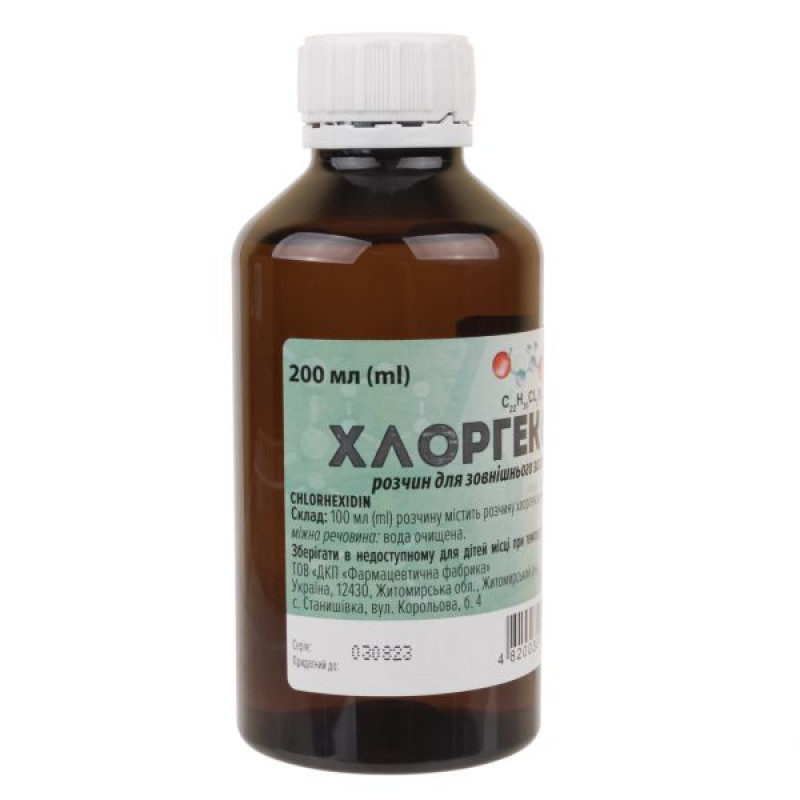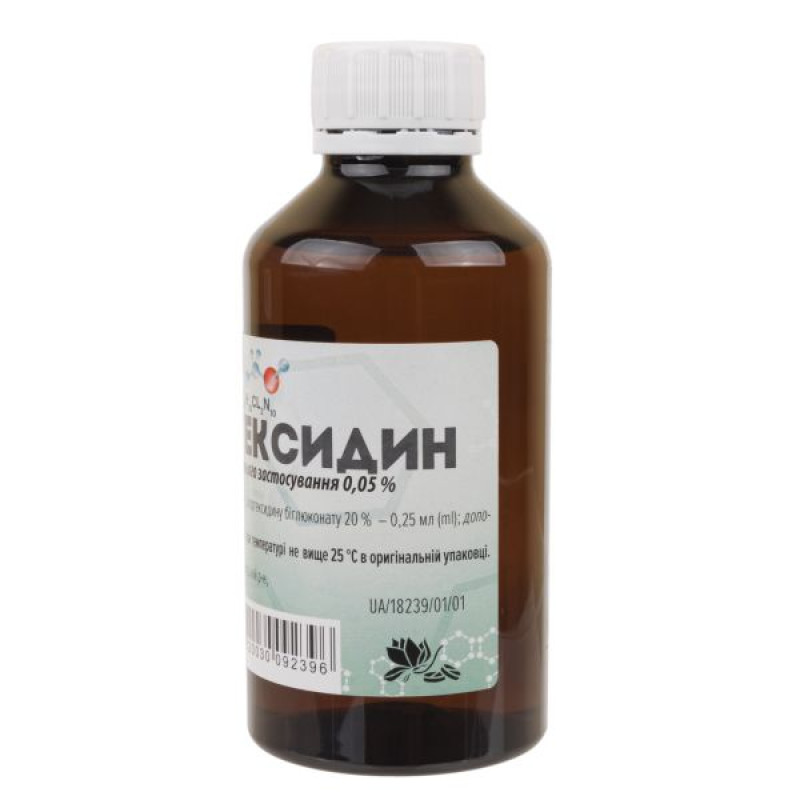Chlorhexidine solution for external use 0.05% bottle 200 ml

Instructions Chlorhexidine solution for external use 0.05% bottle 200 ml
Composition
active ingredient: chlorhexidine bigluconate;
100 ml of solution contain 20% chlorhexidine bigluconate solution - 0.25 ml;
excipient: purified water.
Dosage form
Solution for external use.
Main physicochemical properties: clear, colorless, odorless liquid.
Pharmacotherapeutic group
Antiseptics and disinfectants.
ATX code D08A C02.
Pharmacological properties
Pharmacodynamics
Chlorhexidine bigluconate is a cationic biguanide. Chlorhexidine has amino groups of cellular proteins. Penetrates into the intracellular membranes of bacterial cells, settles in the cytoplasm and changes the function of the membrane, preventing oxygen consumption, which causes a decrease in the level of adenosine triphosphate (ATP) and cell death. Destroys DNA and disrupts DNA synthesis in microorganisms. Provides long-lasting persistent antimicrobial activity, preventing the reproduction of microorganisms for at least 6 hours after application of the drug.
Chlorhexidine bigluconate has a rapid and pronounced effect on gram-positive and gram-negative bacteria (Treponema pallidum, Chlamidia spp., Ureaplasma spp., Neisseria gonorrhoeae, Gardnerella vaginalis, Bacteroides fragilis), protozoa (Trichomonas vaginalis), viruses (Herpes virus). In the presence of blood and other organic substances, the antimicrobial activity of chlorhexidine bigluconate does not decrease.
Pharmacokinetics
Does not penetrate intact skin. Practically not absorbed from the gastrointestinal tract. After accidental ingestion of 300 mg, the maximum concentration is reached after 30 minutes and is 0.206 μg/l. It is excreted mainly with feces (90%), less than 1% is excreted by the kidneys.
Indication
For the prevention of sexually transmitted infections (syphilis, gonorrhea, trichomoniasis, chlamydia, ureaplasmosis, genital herpes).
For disinfection of purulent wounds, infected burn surfaces; for the treatment of skin and mucous membrane infections in surgery, obstetrics, gynecology, urology (urethritis, urethroprostatitis), dentistry (rinsing and irrigation - gingivitis, stomatitis, aphthae, periodontitis, alveolitis).
For disinfection of microtraumas (wounds, scratches, burns).
Contraindication
Hypersensitivity to the components of the drug. Tendency to allergic reactions and allergic diseases, dermatitis, viral skin diseases.
It is not recommended for use in the treatment of the conjunctiva and rinsing of cavities, on wounds with a large surface area, during operations in areas of the central nervous system and auditory canal, in ophthalmology, or for introduction into the auditory canal.
Interaction with other medicinal products and other types of interactions
To avoid the development of dermatitis, it is not advisable to use chlorhexidine and iodine preparations simultaneously.
Chlorhexidine bigluconate is a cationic substance and is incompatible with soap and other anionic substances (saponins, sodium lauryl sulfate, sodium carboxymethylcellulose, colloids, gum arabic).
Compatible with drugs containing a cationic group (benzalkonium chloride, cetrimonium bromide).
Ethanol enhances the effect of the drug.
At a concentration of 0.05%, chlorhexidine bigluconate is incompatible with borates, carbonates, chlorides, citrates, phosphates, and sulfates, as insoluble precipitates are formed.
Application features
It is necessary to avoid getting the drug inside the wound in patients with open craniocerebral trauma, spinal cord injury, perforation of the eardrum. If the solution gets on the mucous membranes of the eyes, they should be washed quickly and thoroughly with water. The contact of hypochlorite bleaching agents with tissues that have previously been in contact with drugs containing chlorhexidine may contribute to the appearance of brown spots on them. The bactericidal effect of the drug increases with increasing temperature. At temperatures above 100 ° C, chlorhexidine bigluconate partially decomposes.
The drug is practically not absorbed in the stomach. In case of accidental ingestion, the stomach should be washed using raw milk, raw egg, gelatin. If necessary, symptomatic therapy should be carried out.
Do not dilute with hard water. Can be sterilized in an autoclave at 116°C for 30 minutes. Do not sterilize with ionizing radiation.
You should not violate the rules for using the medicine - this may harm your health.
Use during pregnancy or breastfeeding
During pregnancy or breastfeeding, the drug should be used only if the expected benefit to the mother outweighs the potential risk to the fetus/child. Do not treat the surface of the mammary glands before breastfeeding.
Ability to influence reaction speed when driving vehicles or other mechanisms
Does not affect.
Method of administration and doses
Before using the drug for the prevention of sexually transmitted infections, you should empty your bladder, wash your hands and genitals. After that, remove the cap, press on the walls of the bottle and treat the skin of the pubis, inner thighs, and genitals with a jet of solution. Insert the nozzle into the external opening of the urethra, press it tightly with your hand against the ureter and squeeze out 2–3 ml of solution (for men) or 1–2 ml of solution (for women; into the vagina - 5–10 ml). Then, without opening your fingers, pull the nozzle out of the urethra and hold the solution for 2–3 minutes. Women should spray the vagina with the remaining solution. After the procedure, it is recommended not to empty the bladder for 2 hours. This preventive measure is effective if it is carried out no later than 2 hours after sexual intercourse.
Comprehensive treatment of urethritis and urethroprostatitis is carried out by injecting 2–3 ml of the drug solution into the urethra 1–2 times a day, the course of treatment is 10 days. The procedures are prescribed every other day.
In case of microtraumas, treat the skin around the wound with the solution, then apply a napkin moistened with the solution to the wound and secure it with a bandage or plaster. Change the bandage 2–3 times a day. The duration of treatment depends on the course of the disease, the nature of the complex therapy and the tolerability of the drug.
The drug solution should be used in the form of irrigations, rinses and applications: apply 5–10 ml of the solution to the affected surface of the skin or mucous membranes with exposure for 1–3 minutes 2–3 times a day (on a swab or by irrigation).
During pregnancy or breastfeeding, the drug should be used in the usual recommended doses.
Children
Do not use in children under 12 years of age.
Overdose
Cases of overdose with external use are unknown.
Incorrect oral administration of a large amount of the substance (300 ml of chlorhexidine) leads to death with signs of liver and kidney failure.
If ingested, the drug is practically not adsorbed - the stomach should be washed using milk, gelatin or raw egg. If necessary, symptomatic therapy is carried out.
Adverse reactions
In some cases, with increased individual sensitivity, hypersensitivity reactions, dryness and itching of the skin, dermatitis, stickiness of the skin of the hands, which is observed for 3–5 minutes, photosensitization are possible. In the treatment of gingivitis - discoloration of tooth enamel, tartar deposits, taste disturbances.
If any adverse reactions occur, discontinue use of the drug and consult a doctor.
Expiration date
3 years.
Do not use after the expiry date stated on the packaging.
Storage conditions
Store out of the reach of children at a temperature not exceeding 25 ºС in the original packaging.
Packaging
200 ml in bottles with a lid.
Vacation category
Without a prescription.
Producer
LLC "SKP "Pharmaceutical Factory".
Location of the manufacturer and address of its place of business.
Ukraine, 12430, Zhytomyr region, Zhytomyr district, Stanyshivka village, Koroleva st., bldg. 4.
There are no reviews for this product.
There are no reviews for this product, be the first to leave your review.
No questions about this product, be the first and ask your question.








